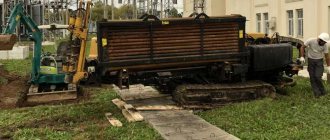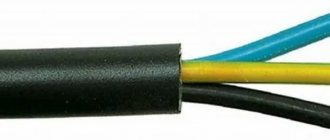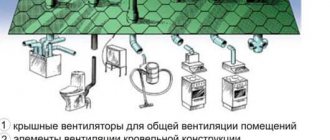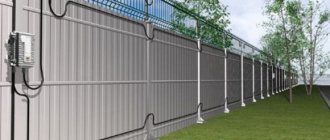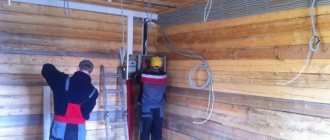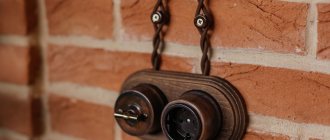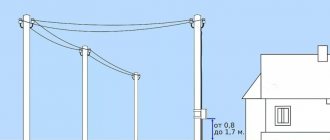To eliminate the possibility of damage to electrical wiring and ensure its reliable protection from the negative effects of the environment when laid in the ground or walls of a building, you should be concerned about the presence of a special casing, which can act as HDPE pipe. You can learn about the features of the product, its varieties, selection criteria and installation options from this article.
HDPE pipe is used to protect the power cable in the ground.
Choosing a cable brand for laying in the ground
To organize the power supply of a building, street, landscape or decorative lighting, you will need special cable products, which are most often laid in the ground. This method is the most reliable and aesthetic. The underground cable is protected from adverse external influences such as wind, frost, and ultraviolet rays. The cable brand is selected based on the type of soil, its corrosiveness and further operating conditions.
For underground installation, only special types of cable can be used.
Both armored cables and products without special protective cover can be laid underground. In the first case, the wiring does not need additional protection. The cost of an armored cable for laying in the ground will be an order of magnitude higher than a product without a protective sheath. When laying unarmored cables, as well as crossing a power route with a road or railway or other communications, it is necessary to use special protective structures.
This can be brickwork or concrete slabs, with the help of which special channels are created.
Concrete, asbestos-cement, ceramic or steel pipes are often used. The easiest to install are protective cases made of HDPE or PVC pipes for cables. On a note! If the distance between the supporting objects is small, then open laying of the cable through the air is also allowed (in the country house, or in the local area).
Organization of lightning rods
If electricity is introduced into the room using the TN-S grounding system, there is a conductor inside the cable that is connected to the physical ground. If there are no higher height grounded structures near the installation site, the wiring may be “attacked” by lightning. How to protect the power cable and premises during a thunderstorm?
The ideal option is a lightning rod on a structure that dominates in height. If the fence is metal, you already ground it, no additional work is required. If these conditions cannot be met, the cable must be protected locally.
- Armored cable - requires grounding of the outer conductive sheath.
- Laying in a metal hose or metal box - the casing itself is connected to the “ground”.
- The cable is laid along a steel strip - it is grounded.
In the case where a regular power wire is laid along a wooden or stone fence, a lightning rod is required in the immediate vicinity.
Characteristics of armored cable for laying in the ground
An armored power cable for laying in the ground is represented by a product whose conductive cores are located inside a metal armored sheath. It provides them with reliable protection from mechanical damage. Armored cable is produced in several brands. Belonging to a certain group is indicated by a letter abbreviation that reflects the type of material of the current-carrying conductors (TC), armor, screens and outer shell.
The armored cable is protected by a metal sheath.
Using digital identifiers, you can determine the number of fuel fluids, their cross-section and voltage. Based on the material of the current-carrying conductor, copper and aluminum armored cables (A) are produced. A layer of insulation made of polyvinyl chloride (B), polyethylene (Pv) or in the form of a polymer composition (P) is applied over the core.
Based on the material and type of armor, the cable comes with wire (K) or tape (P) armor, lead (SB), or steel (B) protection. The tape casing gives the product additional mechanical strength and moisture resistance. The steel tape is applied in two layers, eliminating the formation of gaps, creating a continuous armor layer. The wire braiding gives the product high flexibility, which reduces the risk of cable breakage due to ground movement.
The protective hose can be made of polyethylene (Шп) or PVC (Шв). The wall thickness is in the range of 1.7-3.1 mm. Plastic hoses are sealed along their entire length. There are no dents or cracks in their structure. The polyethylene shell is more moisture resistant. The protective hose protects the armor protection of the product from mechanical loads, moisture, and chemicals contained in the soil. For example, VBBShv 5x10 is an armored cable for laying in the ground with PVC insulation, armor made of galvanized steel tapes without a cushion with a polyvinyl chloride sheath, has 5 copper cores with a cross-section of 10 mm².
The type of armored cable is selected based on operating conditions. When installing cable products in soils with a high content of aggressive chemicals, in areas exposed to electrocorrosion, preference should be given to products with aluminum protection or lead armor. In areas of soil subsidence or areas with strong mechanical impact, products with wire armor protection should be used. For standard operating conditions, an armored cable for laying in the ground 4x10 with an armor braid made of steel tapes will be sufficient.
There are many types of armored cables.
Main settings
When choosing products, you should pay attention to the following parameters:
Rated voltage
This parameter is the first thing people pay attention to, especially if you are laying a line not of 0.4 kV, but of 6, 10 or more kilovolts. It is affected by the quality and thickness of the insulation. The cross-section of wires and cables is an equally important parameter that determines how much power the cable can withstand. Availability and type of armor. Availability of a screen. Core flexibility class
It plays an important role in electrical installations in small spaces such as electrical panels.
It is worth noting that all parameters and detailed requirements are described in state standards and specifications for cable production. An example of such regulatory documents are:
- GOST 16442-80. Standard for cables VVG, AVVG, AVBbShv, VBbShv.
- GOST 22483-77. Electrical resistance of the core.
- GOST 24641-81. Aluminum and lead sheaths for power cables.
- GOST 7006-72. Protective covers of cables (variations, requirements).
- GOST 23286-78. Insulation and sheath thicknesses, voltage tests.
- GOST 31996-2012. Power cables with plastic insulation for rated voltage 0.66, 1, 3 kV.
Using aluminum or copper armored cable
Aluminum or copper armored cable for laying in the ground is laid in a trench to a depth of no more than 70-80 cm. When installing several power lines, certain conditions must be observed. For cable products with a power of up to 10 kW, adjacent lines must be at a distance of more than 10 cm, and with a power of 20-35 kW - at least 25 cm.
Note! When installing an armored cable, it is grounded.
Laying the armored cable in the ground is carried out in the following sequence:
- preparing the trench according to the planned route plan;
- leveling and compacting the bottom of the trench, followed by pouring a layer of sand 10 cm high, which must be cleared of any large impurities that could cause damage to the integrity of the cable sheath;
- leveling the surface of the sand cushion;
- checking the cable for integrity;
- free laying of power threads on a sand cushion without tension, so as not to provoke the appearance of tensile forces during possible soil displacement;
- checking the cable line for the absence of short circuits, which is carried out between current-carrying conductors, TC and armor;
Aluminum or copper armored cable is laid to a depth of up to 80 cm.
- backfilling the cable with a layer of sand 10 cm thick and then compacting it;
- backfilling the trench with soil to a height of 15-20 cm;
- laying warning polymer tape with the inscription “Caution cable”;
- final filling of the trench with soil with the formation of a small slide, which will eliminate the formation of failures in the process of soil subsidence;
- performing a control check for short circuit of current-carrying conductors to the ground.
Backfilling the trench with sand
Mistake #5
The bottom layer of the trench must be filled with sand; do not skip this step.
Otherwise, sharp pebbles and other foreign elements in the ground will damage the insulation after some time.
Mistake #6
The sand must be compacted. Do not lay the cable on a loose base.
What to do if you don’t have sand in stock and don’t want to order it? In this case, sift the excavated soil.
The fraction of individual elements after sifting should be no more than 5 mm.
Is it possible to do without this sand pillow or its equivalent? Why is it even needed? No you can not.
In addition to protecting the insulation from sharp objects, it plays another important role. The layer of sand under and above the cable is practically not subject to heaving.
It can be easily compacted, as a result of which there is no subsidence of the soil in the trench. No drawdown - no voids.
Namely, they lead to local overheating of the cable. The result is a situation where, in the place where a shallow hole is formed, the cable heats up significantly more than in the same area, but a couple of meters away.
Due to the temperature difference, the cable begins to “pull”. Under significant loads, the PVC insulation bursts and subsequently begins to actively suck moisture through these microcracks.
Well, don’t forget about the drainage properties of sand. Even if water reaches a depth of 0.7 m, it will pass through the sand without stopping near the cable line itself.
HDPE pipe: what is it, abbreviation explanation
When laying an electrical cable without armor in the ground or wall of a building, it is necessary to ensure its integrity and protection from mechanical and chemical damage. For this purpose, it is placed in a special tube-shaped case. Previously, concrete or metal products were often used. They significantly complicated the process of installing power lines. This is primarily due to the significant weight of the products. The metal casing is prone to corrosion. When welding individual sections of the pipe, scale formed on the inner surface, which could damage the cable.
However, progress does not stand still. And today HDPE pipes are used for laying cables. What kind of pipe is this? Low-pressure polyethylene technical pipes are manufactured by extrusion at industrial enterprises, where the quality of the product is immediately controlled automatically, and then it undergoes additional control by specialists to identify possible defects.
Double-walled HDPE pipe for installation of electrical cables.
Two grades of polyethylene are used as raw materials: LDPE and MDPE. They contain a fire retardant, which makes the products resistant to fire. The structure of the material must be smooth, without cracks, swelling, sagging or other defects.
Some manufacturers produce electrical PE/HDPE pipes for cable laying from recycled materials, which reduces the cost of production. For their production, polyethylene crumbs are used, which is obtained after processing rubble waste, followed by crushing the resulting mass into a small fraction. This production feature does not affect the quality of technical pipes, but has a positive impact on environmental protection.
HDPE pipe: it is a protective case for the electrical cable
Technical HDPE pipes for cables are distinguished by strength, elasticity, frost resistance, resistance to chemical environments, the ability to bend without loss of performance, restore linear dimension, withstand significant mechanical and vibration loads, and temperature changes. The material is environmentally friendly and does not contain harmful impurities. The pipes are also light in weight and have a low price. Laying cables in the ground using a polyethylene sheath is quick and easy. A distinctive feature of the product is its black color. There are also gray options.
Note! The presence of white streaks on the pipe indicates a high content of high-density polyethylene in the composition of the material, which reduces the rigidity of the products. It is not recommended to use such pipes for laying communications.
The HDPE pipe acts as a protective casing for the cable.
The material is a dielectric, and therefore does not require grounding. The products have a smooth inner surface and uniform wall thickness, which facilitates easy and quick tightening of cable products inside the product. Individual sections are connected to each other by welding. The service life of such a casing is at least 50 years.
The operating temperature of the products ranges from -25 to 70°C. The density of polyethylene is 0.949-0.953 g/cm³. The working pressure of the material is determined by the type of pipe and is 0.25 MPa for light products, 0.4 MPa for medium-light, 0.6 MPa for medium and 1 MPa for heavy pipes. The coefficient of thermal expansion is 0.15-0.2 mm/mK. HDPE pipes belong to flammability classes B1 and B2.
Advantages and disadvantages
HDPE pipes for cable protection have the following advantages:
- Light weight compared to metal hoses.
- Good electrical insulating properties.
- Resistant to chemicals.
- High degree of wear resistance.
- Ability to withstand prolonged contact with an aggressive environment.
- Low thermal conductivity, due to which condensation does not form.
- Frost resistance. Pipes do not collapse when water freezes in them.
- Affordable price. For electrical work, pipes made from recycled materials are used, the cost of which is 30–50% lower than products made from primary polymer granules.
- Elasticity. It can be bent in difficult areas without using shaped parts.
- The smoothness of the inner walls makes it easy to pull the cable through.
- Sufficient rigidity.
- Bacteriological resistance.
- Resistance to mechanical damage and vibration loads.
- Low coefficient of linear expansion.
- Resistance to temperature changes.
Disadvantages include the ability of HDPE pipes to support and spread combustion. Therefore, they must be embedded inside fire-resistant materials, such as concrete screed, cement mortar, or laid in the ground.
Reasons for the demand for HDPE pipes for laying cables in the ground
HDPE pipes are used as a protective casing for power supply, telephony, video surveillance, computer networks, control, fire and emergency alarm lines, which can be laid in an open, semi-hidden or hidden way. The case in the form of a HDPE pipe provides reliable protection of cable products from various mechanical and chemical influences. It also eliminates the possibility of electric shock in the event of damage to the network insulation and fire due to a short circuit. Thanks to the special design with a smooth inner surface, easy pulling of all types of cables into the pipe cavity is ensured.
HDPE pipes for cables in the ground are lightweight, which simplifies their transportation and installation. They are not susceptible to corrosion and the influence of other negative factors, so they do not need to create special conditions for storing products. Due to the elasticity of the material and bendability, PE technical pipes can be laid along any trajectory without the use of additional connecting elements, without losing the integrity of the structure.
HDPE pipes have numerous advantages of use.
Note! HDPE pipes should not be bent too much, as kinks may appear on the products, which will complicate further installation.
HDPE pipes do not conduct electric current, therefore they do not require grounding or cathodic protection devices. The products are able to withstand a wide range of temperatures without loss of technical and operational qualities. They do not accumulate condensation on the surface, due to low thermal conductivity, and do not emit harmful substances.
Types of HDPE pipes for laying cables in the ground
Manufacturers produce HDPE pipes in two variations: smooth and with a corrugated wall. They differ in individual technical characteristics and the possibility of installation under certain conditions.
Smooth technical HDPE pipes for cables have a rigid structure and high mechanical strength. They are black in color. Such pipes are produced in two variations: single-layer reinforced and two-layer unreinforced. The first option is used for laying cable products in concrete and brick structures, floor screeds. Double-layer reinforced pipes can be used in more difficult conditions.
Smooth pipe made of low pressure polyethylene.
Note! When making transitions and turns in cable ducts made of smooth HDPE pipes, special fittings should be used.
Corrugated HDPE pipes for cables can be used for both underground and above-ground installation of communications. They have two-layer walls, the inner layer of which is made of LDPE and has a smooth surface, and the outer layer is made of HDPE and has a corrugated structure. Such pipes have good flexibility, the ability to withstand significant loads, and the ability to lay them at different depths and curved sections.
Types of corrugated pipes for laying cables in the ground
Corrugated pipes, based on their ability to withstand external pressure, are divided into light, medium and heavy. The first option has high elasticity and the ability to bend without compromising the integrity of the product. Such pipes are used when laying electrical networks with a power not exceeding 1 kW. This could be television and telephone lines, household electrical equipment. Heavy corrugated pipes are additionally equipped with reinforcing mesh, due to which they are heavy and less flexible.
There are also halogen-free pipes that have increased fire protection. They do not emit hazardous compounds into the atmosphere even when exposed to open fire for a long time. Such products have the ability to self-extinguish. They are most often used for laying cables inside a building.
Corrugated pipes are divided into light, medium and heavy.
Based on the installation method, corrugated HDPE pipes can be with or without a cable pulling probe. The first option is more expensive. Such pipes make it easy and quick to pull the cable inside the product. Options without a probe provide more labor-intensive installation of cable products, which will require a special pulling mechanism.
HDPE pipes are painted in different colors depending on their purpose. Red products are used for high-voltage routes. Blue pipes are intended for laying telecommunications and communication lines, while black pipes are characterized by versatility.
HDPE pipe for cable: selection criteria
The main criterion when choosing HDPE pipes for cables is the throughput of the product. The value of the internal diameter of the pipe must correspond to the total cross-sectional area of the cable products that will be laid in its internal cavity. According to GOST, technical HDPE pipe is produced with a diameter of 16-225 mm with a wall thickness of 2-30 mm. Products with a cross section of up to 90 mm are produced in coils of 100 or 200 mm. Larger diameter pipes are manufactured in 12 m long sections.
On a note ! No more than 4 cables can be installed simultaneously in one HDPE pipe.
HDPE pipe with a probe for cable pulling.
The next important criterion is the strength of the product. Pipes with a small value are used for laying cables inside the building, and with a large value - underground. You can calculate the strength indicator yourself by determining the SDR parameter. To do this, it is necessary to calculate the ratio of the outer diameter to the pipe wall thickness. The lower this indicator, the higher the strength characteristics of the pipe.
Each factory product is marked with a marking that identifies the characteristics of the pipe, such as the name of the manufacturer, material of manufacture, SDR parameter, diameter, wall thickness, operating pressure, production standard, purpose and date of manufacture.
How to close a trench
Despite the apparent simplicity of the issue of backfilling the trench after installing the main line, this work should be approached very responsibly and competently.
Backfilling the trench
To close the trench, you can use the soil extracted during digging, if it is sufficiently clean and loose. Large stones larger than 2.5-3 cm must be removed from the ground.
When backfilling the soil, you must follow the basic rules:
- carry out work slowly and carefully;
- Do not pour earth directly onto the pipeline, but lay it and compact it in layers of 10 cm on both sides of the pipeline, fixing it horizontally.
For compaction, you can use fine gravel or crushed stone, alternating backfilling with layers of soil.
Options for laying HDPE pipes for cable laying
Laying the cable underground in a HDPE pipe can be done above-ground or underground, or inside the building.
Regardless of the method of laying the protective casing, there are certain installation rules:
- The ambient temperature must not be lower than -30°C;
- if the cable depth is more than 2 m, a concrete channel with a wall thickness of 80-100 mm is provided;
- butt joints must be airtight; for this purpose, compression couplings, press fittings or butt welding are used;
- cables of different networks should not be located in the cavity of one channel;
Cables from different networks are placed in separate channels.
- It is prohibited to bend the pipe at an acute angle, this can lead to a break in the product;
- the length of the section between the boxes should not be more than 25 m;
- when laying cables in an open way outside the building, it is necessary to use black HDPE corrugation, which is resistant to ultraviolet radiation;
- To drain condensate, the pipe must be laid with an inclination towards the duct boxes, where moisture will collect.
Cable laying in HDPE pipe inside the building is carried out in the following sequence:
- marking the cable route;
- creating grooves in the enclosing elements of the room (if necessary);
- fastening the pipe to the building envelope. When laying along walls or along the ceiling, special holders with latches are used. Fastening to the ceiling is carried out using metal brackets;
- connecting pipeline sections;
- sealing holes. For wide and deep channels, cement mortar is used. To seal small holes, you can use plaster;
- pulling cable communications inside the channel, which must be in a free state without tension.
HDPE pipes for cable laying are placed in pre-dug trenches.
The advantage of this option
Given that there are different installation methods, what are the advantages of this method? Since the pipe is round in shape, it is ideal for laying wire or cable in it. As the conductor is pushed through, it bends less frequently, requiring less effort. Such structures have a smooth turn, unlike the box, which also facilitates installation and protects the wire from breaking.
The round section can withstand more load than any other. Cables laid underground in this way will be more protected from compressive loads and surface deformation, for example, during building subsidence.
External cable laying in a pipe in the ground
Laying the cable in the ground in a corrugated cable is best done in a closed way with the construction of a trench in the ground. This option has more advantages compared to the installation of air routes. The cable in the ground will be reliably protected from precipitation, ultraviolet rays, temperature changes, wind loads and other adverse factors. In addition, it will be inaccessible to thieves of non-ferrous metals.
Note! Before starting work, you should inspect the cable for the integrity of its sheath.
The process of laying cables in a trench is carried out in the following sequence:
- marking for the future trench;
- excavation of soil to the required depth;
- compacting the bottom of the trench with the arrangement of a sand cushion 10-15 cm thick;
- laying HDPE pipes;
- joining sections using resistance welding. The use of fittings is not allowed, since the integrity of the route may be compromised;
- pulling cable products inside the pipe without tension using metal wire or a special nylon broach;
- filling the case with a layer of sand 10-20 cm thick;
- backfilling the trench with soil.
On a note! To make it easier to find an already laid route in the future, it is recommended to install signal posts above it.
Only intact pipes are suitable for use, without any damage or kinks.
Selection of pipes according to technical characteristics
The greater the depth to which the cable corrugation is laid in the ground, the greater the mechanical strength it should have. Strength depends not only on the thickness of the walls, but on their ratio to the diameter of the pipe. It is determined by dividing the outer diameter by the wall thickness and is indicated by the SDR indicator: the lower it is, the higher the reliability of the product.
Table for determining SDR Source moikolodets.ru
Trenchless cable laying in the ground in a HDPE pipe
In cramped areas where it is not possible to dig a trench, a trenchless method of laying power cables in the ground is used. For this, special equipment is used to drill the soil in a horizontal direction. The cost of laying a cable in the ground per linear meter will be 1.5-2 times higher than the cost of trench laying communications, and starts from 350 rubles.
Work begins with drilling a so-called “pilot” well using a special tip. It is mounted on a flexible rod, which allows it to overcome natural obstacles in the ground. To control the trajectory of movement and correct its direction, the tip has a navigation device and cooling holes. Simultaneously with drilling, a concrete solution is supplied, which cools the tool, strengthens the walls of the channel, protecting it from collapse, and reduces the friction force that occurs when pulling through the line of communications.
Next, the well is expanded using a trimmer, which is installed in place of the drill head. Then the pipe is pulled into which the cable products are first inserted. The structure is attached to a special rod of the HDD installation, with the help of which it is pulled through the well.
The use of HDPE pipes for cable products is a reliable, convenient and cheap option for laying power communications. With the right choice of products and compliance with all installation rules, you will be able to obtain a safe and durable wiring that will not be influenced by many external factors.
